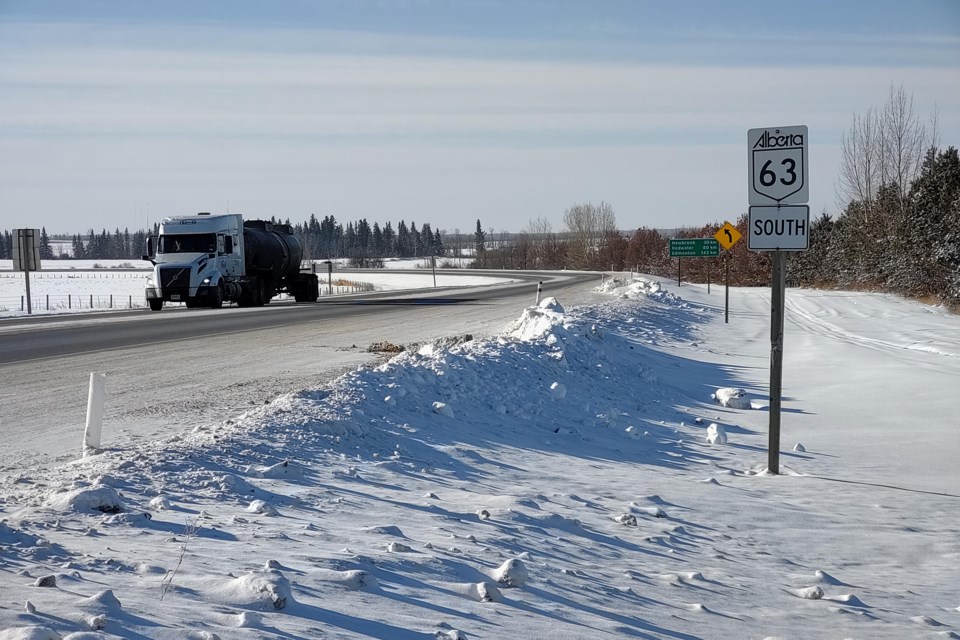BOYLE – It you haven’t had your own close call driving on Highway 63, you certainly know someone who has, and you’re well aware of the dangers.
Over the years, numerous safety campaigns to draw attention and awareness to the so-called “Highway of Death” have been organized, but the highway has maintained its deadly reputation. The Village of Boyle will now be approaching its neighbours and emergency responders to help lobby for improved winter traction material on the highway, especially on its many curves.
“So, the highways have changed over the years because we're no longer allowed to use salt,” Boyle mayor Colin Derko said at the village’s Feb. 3 regular council meeting.
Highway maintenance contractors used to lay down salt, but now use a calcium chloride solution, which Derko said just doesn’t get the job done. Whether it’s a matter of keeping material costs down, as salt is known to be quite pricey, he is unsure.
The current solution seems to turn to slime, said Derko, who spends a lot of time on area highways and wants to have a constructive discussion with government officials on changing the situation.
“I don't think it's a matter of trying to switch the world and the way they do it, but it is a major hazard on our corners where the trucks are coming in and they're slowly packing that snow. The tires are hot, especially the big trucks, and we're getting really slippery on our corners here on Highway 63. Worse yet, is Grassland,” he said.
Boyle is situated on one of the highway’s many curves, and is eight kilometres east of the junction with Highway 663, another large curve that has proven to be especially dangerous. Just weeks ago, two semi-trucks collided head-on there, resulting in multiple deaths.
Even during the best driving conditions in the summer, the highway maintains its reputation. Between the wildlife; distracted, impaired, inattentive, or speeding drivers; and the constant heavy industrial traffic heading north to the oil patch with workers and equipment, then heading back south with the fruits of their labour, drivers need to be wary of many factors.
Derko stressed that his intent isn’t to criticize, but to work constructively with Alberta Transportation to find a solution that will benefit everyone.
“I think it's the product, and I think it's just maybe a different way of doing something,” he said.” I don't know … why we gotta wait for somebody to die until we do something about it. Somebody has died there, multiple times coming out of Grassland and there have been accidents there in the wintertime that are directly related.”
Village council passed a motion to approach Athabasca County and the Town of Athabasca, along with local RCMP, fire and EMS for their support, and intend to send a letter to government officials, stating their desire to work with the government to find a solution.
“There's definitely an answer there. And there's a way to make it better. But is it costs? Is it stubbornness? Is it that they didn’t know? Like I said, I see their (EMCON) trucks in town all the time, so they're not neglecting it. It's just the product,” said Derko, adding that extreme cold is also a factor with the calcium chloride, as it doesn’t work as well once temperatures fall drastically.
“At -30 C, you just see a sheen. And it looks like it's wet, it looks like somebody is currently putting water down.”
About 125 kilometres of Highway 63 run through Athabasca County, and local emergency services are the ones that respond to those calls when they come in, which is also a concern for Derko.
Athabasca County Fire Services regional chief Sheldon Schoepp recently presented his year-end report for 2020 for county councillors, and noted the Highway 63 Rescue Crew, which consists primarily of two members who are on call 24/7, responded to 90 page-outs in 2020. Crews from the Wandering River Fire Department respond in tandem to calls on the highway as well.
Schoepp said about 70 per cent of the calls the Wandering River department respond to are motor vehicle accidents.


